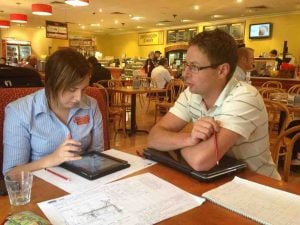When we begin our Lean Journey, the stage is set during the initial workshops to establish our current state, create our proposed future state and develop a plan to get us from here to there. During the implementation of the plan, we follow up between workshop with coaching and support for the individuals involved. Here we will look at the critical elements of coaching to ensure we get the best out of people during our lean implementation. This coaching may occur between both the TXM Facilitator and key people within your business, as well as between your Lean Champion and team members. It becomes a “coaching the coach” opportunity.
During lean implementation, the coach guides the coachee in what to do next and balances the amount of direction so as not to limit the opportunity for the coachee to think the problem through for themselves. Too many instructions deprive them of ownership of the issue being discussed. The focus of the coaching is to improve the skills of the problem owner, the coach, as the next steps are taken to improve the situation.

The coach’s role is to use open questioning to help the coachee become aware of what is needed and how to gather information to build greater insight. The discussion develops the prompts for the person being coached to consider new ideas, concepts and fact-based observation.
The Coaching Approach
The scientific method of plan-do-check-act (PDCA) is also applied to a coaching cycle. The coach needs to plan his approach, using open questions to help the coachee’s grasp of the situation around the issue being discussed. After the coaching session, the coach needs to check and assess the coachee’s problem-solving capability, continuing to observe and provide constructive feedback without interpretation to the coachee’s efforts.
Three Critical Elements of Coaching
Element 1 – Prepare Your Questions
A coach needs to prepare the questions before a coaching session. These questions can become part of your standard coaching tool kit.
The questions that a coach needs to ask are those that he doesn’t already know the answer to or questions that don’t have a standard reply that he would expect. The challenge is to ensure the coach has open questions that help to dig deeper, rather than leading questions about what the coach is already thinking or may have preconditioned assumptions about.
A starting question might be “What is on your mind about the issue?” and follow up with “Is there anything else?” These two questions can lead to a strong start to the conversation and from there the coach can explore the issue by restating the problem as the coach currently understands the situation. This can then lead to discussing the challenges around the actual process, for example, “Where should we start?” or “What is the next step?”
If the coachee is facing a particularly complex issue, a question like “What are the challenges for you here?” may help the coachee to reflect internally before replying, which can lead to an improved understanding of the challenges being faced.
Element 2 – Question with Respect
Coaching must be approached from a position as equals when meeting about the problem. This will help to develop a connection with the person, understanding their role and the challenges they face. Help the coachee to develop more in-depth answers to the questions, rather than simply answer with a “yes” or “no”. The challenge is to enquire further and move to a deeper level of understanding about the issue.
Element 3 – Actively Listen to the Reply
For the coach, most of the message is delivered by the way the person is speaking, their tone expressions, body language and the context that is discussed. All of these elements are important during the conversation and are taken in subconsciously but when the coach concentrates and develop their listening skills, he will get a deeper understanding of the coachee and issues.
When the coach has asked an open question, listen to what the coachee is saying. They need to limit the thinking of their own thoughts. Listen for understanding and hidden meaning. Is what the coachee saying aligned with their tone and body language? Without active listening, the coach may hear only the words from the coachee and miss some meaning. By tuning into the tone and the meaning underneath allows for the exchange of information to flow. Concentrating on the reply can lead to helpful insights and pieces of information about what is really being said.
For the coach, his state of awareness as he listens to the message is not the only thing that is happening. They also are experiencing the event which creates inner thoughts and emotions about what the coach is hearing. The coach may be wondering about the person and what they are telling you and why, and what they want you to understand. This internal feedback will help you extend your understanding of the situation.
In Conclusion
As a coach, it can be a hard road to follow but the focus of his efforts is to improve the coachee’s skills as they find ways to address the issues and progress towards a solution. Following the Plan – Do – Check – Act improvement cycle will help the coach to be ready to improve their own coaching skills. Stepping through the three critical elements of coaching will set them up for success.




